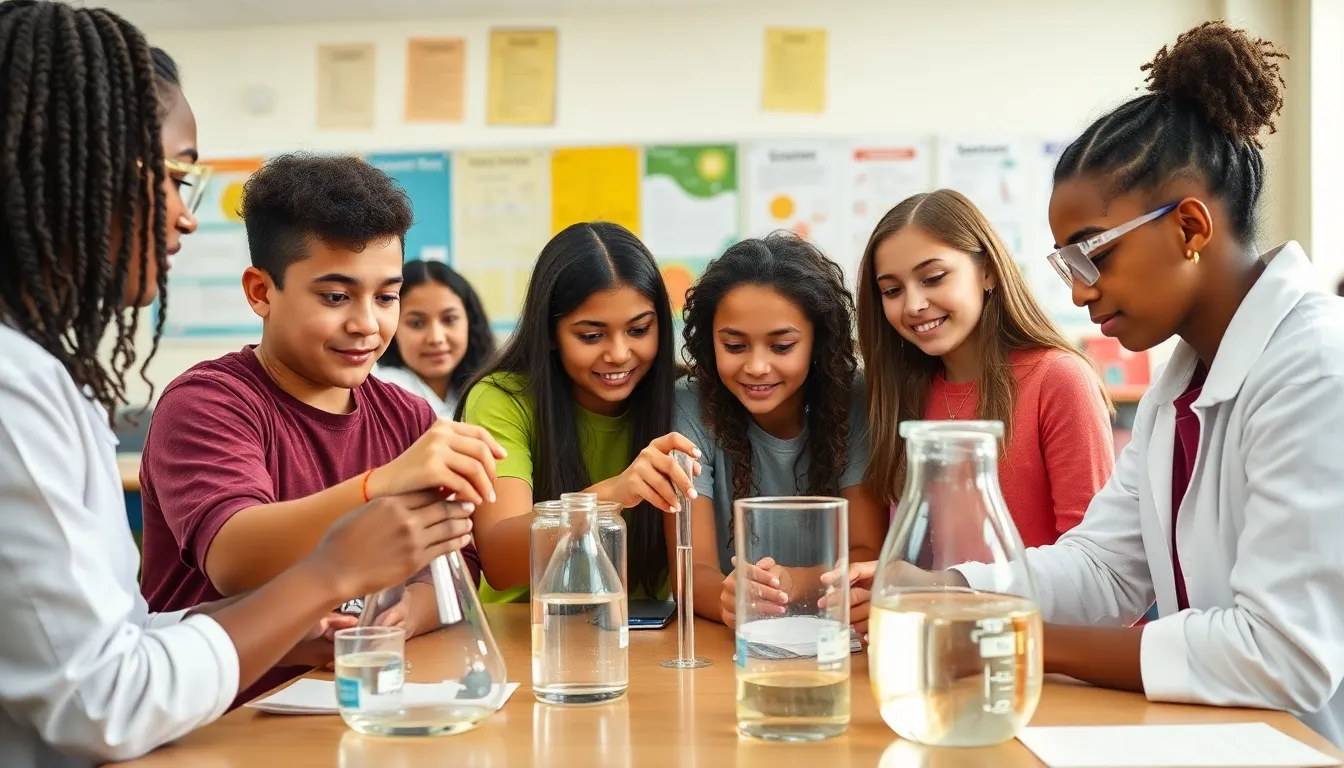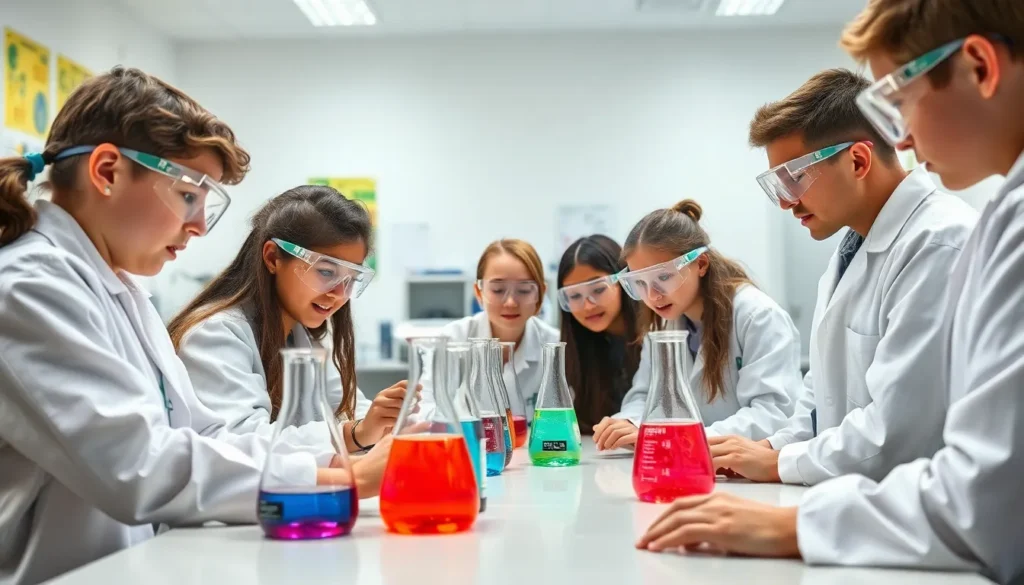Table of Contents
ToggleIn today’s fast-paced world, a strong science curriculum is more crucial than ever. It shapes the minds of future innovators and problem solvers, equipping students with the knowledge and skills to tackle real-world challenges. As technology advances and global issues arise, understanding scientific principles becomes essential for informed citizenship and career readiness.
Educators face the exciting challenge of designing engaging and relevant science programs that inspire curiosity and critical thinking. From hands-on experiments to interdisciplinary approaches, a well-rounded curriculum can ignite a passion for discovery. This article explores the key components of an effective science curriculum and highlights innovative strategies that can enhance student learning and engagement.
Overview of Science Curriculum
A robust science curriculum focuses on cultivating critical thinking, problem-solving skills, and a passion for inquiry. It encompasses various disciplines, including biology, chemistry, physics, and Earth science. Each discipline offers unique insights into the natural world, promoting a comprehensive understanding of scientific concepts.
Key Components of Science Curriculum
- Content Knowledge: Curriculum includes essential scientific facts, principles, and theories. Students develop an understanding of fundamental topics such as the structure of atoms, ecosystems, and the laws of motion.
- Scientific Inquiry: Engaging students in hands-on experiments fosters curiosity and exploration. Inquiry-based learning invites students to formulate questions, design experiments, and analyze results.
- Interdisciplinary Connections: Integrating science with other subjects; such as mathematics and technology enhances overall comprehension. For instance, applying mathematical principles in physics strengthens problem-solving abilities.
- Real-World Applications: Curriculum aligns science education with real-world issues, such as climate change and health. This relevance encourages students to see the impact of science in their everyday lives and future careers.
Innovative Strategies for Enhancing Engagement
- Project-Based Learning: Assigning projects enables students to explore scientific concepts deeply. Such projects often include collaborative work, promoting teamwork and communication skills.
- Technology Integration: Utilizing digital tools, simulations, and online resources can enhance the learning experience. Technology also supports personalized learning pathways to accommodate diverse learning styles.
- Field Experiences: Organizing field trips to science centers, laboratories, or natural habitats provides experiential learning opportunities. Such experiences allow students to connect theoretical knowledge with practical applications.
- STEM Focus: Emphasizing science, technology, engineering, and mathematics (STEM) prepares students for future careers. Encouraging exploration in these areas enhances creativity and innovation.
Assessment Methods in Science Curriculum
- Formative Assessment: Continuous assessment methods, such as quizzes and group discussions, help monitor student progress. Teachers can adjust instruction based on this ongoing feedback.
- Summative Assessment: Comprehensive examinations and project presentations evaluate students’ understanding of scientific concepts at the course’s end. These assessments often require the application of knowledge to new situations.
- Performance-Based Assessment: Students demonstrate learning through practical tasks, fostering the application of skills in real-world scenarios. This method encourages deeper understanding and retention of scientific principles.
The overall science curriculum focuses on preparing students for a rapidly evolving world. By incorporating essential components, innovative strategies, and effective assessments, educators can create a dynamic learning environment that inspires the next generation of scientists and informed citizens.
Importance of Science Curriculum

A strong science curriculum plays a critical role in education, fostering essential skills and knowledge. It shapes students into informed citizens and prepares them for future challenges.
Development of Critical Thinking
Development of critical thinking occurs through hands-on scientific inquiry and problem-solving strategies. Students analyze data, formulate hypotheses, test theories, and draw conclusions. Engaging in experiments enhances logical reasoning and promotes inquiry-based learning. Inquiry-based learning encourages students to ask questions, explore concepts, and challenge assumptions. The emphasis on critical evaluation of information strengthens decision-making skills, enabling students to navigate complex issues in society.
Preparing for Future Careers
Preparing for future careers in a technologically driven world requires a solid foundation in science. Many professions, such as engineering, healthcare, and environmental science, rely on scientific principles. A comprehensive science curriculum equips students with the knowledge to pursue STEM-related fields and contributes to workforce readiness. Real-world applications of science, such as addressing climate change and public health crises, make learning relevant and directly linked to potential career paths. Integrating technology and innovation within the curriculum enhances skills that employers seek, ensuring students are well-prepared for future employment opportunities.
Components of Science Curriculum
A robust science curriculum comprises multiple essential components that foster students’ understanding and engagement in scientific principles. The curriculum should include core subjects and practical experiences that encourage inquiry and application of knowledge.
Core Subjects in Science
Core subjects within the science curriculum encompass:
- Biology: Focuses on the study of living organisms, including genetics, ecology, and physiology.
- Chemistry: Explores matter, its properties, chemical reactions, and the periodic table.
- Physics: Investigates the laws of motion, energy, forces, and the fundamental principles that govern the universe.
- Earth Science: Examines geological processes, meteorology, oceanography, and environmental science, highlighting Earth’s systems.
These subjects provide a solid foundation for scientific literacy and critical thinking, essential in navigating contemporary scientific challenges.
Hands-on Learning and Experiments
Hands-on learning and experiments form the backbone of an effective science curriculum. Key elements include:
- Laboratory Experiments: Students engage in practical tasks that apply theoretical knowledge, fostering their understanding of scientific concepts.
- Field Studies: Opportunities to conduct research outside the classroom provide real-world context and deepen observational skills.
- Project-Based Learning: Students work on extended projects that tackle complex problems, enhancing their research, collaboration, and critical analysis skills.
These experiential learning opportunities deepen student engagement, promote retention, and prepare learners for future scientific endeavors.
Challenges in Science Curriculum
Several challenges exist within the science curriculum that educators must navigate to foster effective learning environments. These obstacles include addressing diverse learning needs and balancing theory with practical application.
Addressing Diverse Learning Needs
Addressing diverse learning needs poses significant challenges within the science curriculum. Learners come with varying backgrounds, skills, and interests. Tailoring instruction to accommodate individual differences promotes inclusivity and engages all students. Differentiated instruction strategies, such as flexible grouping and personalized resources, enable educators to meet these needs effectively. Implementing assistive technologies and hands-on learning opportunities further support students with disabilities or English language learners. Ensuring accessibility in science education promotes equity and enhances overall student outcomes.
Balancing Theory and Practical Application
Balancing theory and practical application presents a critical challenge within the science curriculum. Solid theoretical foundations are essential for understanding complex scientific concepts. However, without practical application, students may struggle to connect theory to real-world situations. Incorporating project-based learning and laboratory experiments bridges this gap, allowing students to see the relevance of theoretical knowledge. Effective assessment techniques, including performance-based evaluations, measure both conceptual understanding and application of knowledge. Providing opportunities for real-world experiences, such as field trips and internships, strengthens students’ engagement with science and prepares them for future scientific pursuits.
Innovations in Science Curriculum
Innovations in science curriculum focus on enhancing student engagement and fostering a deeper understanding of scientific concepts. New strategies emphasize the integration of technology and interdisciplinary approaches.
Integration of Technology
Integration of technology in science education enhances interactive learning experiences. Tools like virtual labs, simulations, and educational software enable students to conduct experiments that might be impractical in traditional settings. Devices such as tablets and computers provide access to vast resources, including online databases and research articles, allowing students to explore real-time scientific discoveries.
Students engage in collaborative projects using digital platforms that promote communication and teamwork. Learning management systems (LMS) facilitate personalized learning pathways, helping educators track progress and tailor instruction. Technology also introduces coding and robotics, which prepare learners for careers in STEM fields. Schools using technology effectively often see improved motivation and retention rates among students.
Interdisciplinary Approaches
Interdisciplinary approaches blend science with other subjects, enriching the learning experience. Combining science with mathematics, technology, engineering, and art (STEAM) encourages students to see connections among disciplines. For example, projects that incorporate mathematical modeling in environmental science enable students to analyze real data while applying mathematical concepts.
Thematic units that incorporate scientific principles alongside literature, history, and social studies promote critical thinking and problem-solving skills. These projects foster creativity and innovation, encouraging students to address real-world issues like sustainability and public health from multiple perspectives. Schools emphasizing interdisciplinary learning often witness students develop a comprehensive understanding of complex concepts, promoting deeper retention and application of knowledge.
A dynamic science curriculum is vital for nurturing the next generation of innovators and informed citizens. By focusing on hands-on learning and real-world applications, educators can ignite curiosity and foster critical thinking skills essential for navigating today’s complex challenges.
Integrating technology and interdisciplinary approaches enriches the educational experience, making science relevant and engaging. As educators adapt to diverse learning needs, they create inclusive environments that promote exploration and inquiry.
Ultimately, a robust science curriculum not only equips students with essential knowledge but also prepares them for successful careers in a rapidly evolving world. Embracing innovative strategies will ensure that science education remains impactful and inspiring for future generations.



